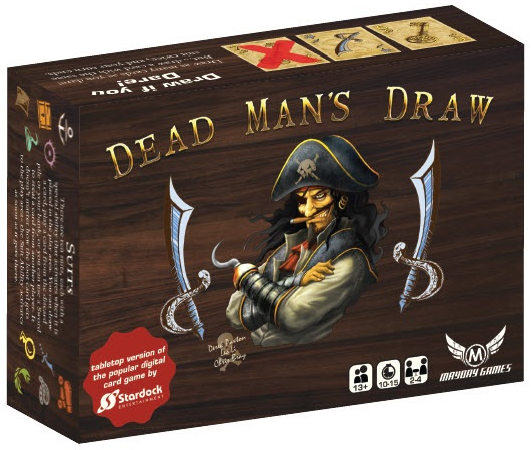
The Basics:
- For ages 7 and up (publisher suggests 13+)
- For 2 to 4 players
- Approximately 15 minutes to complete
Geek Skills:
- Active Listening & Communication
- Counting & Math
- Logical & Critical Decision Making
- Pattern/Color Matching
- Risk vs. Reward
Learning Curve:
- Child – Easy
- Adult – Easy
Theme & Narrative:
- Push your luck in this “Boss Pirate Takes All” game full of risk and loot
Endorsements:
- Gamer Geek mixed!
- Parent Geek approved!
- Child Geek mixed!
Overview
A pirate’s life is not exciting the majority of time. It’s mostly work and boredom. Long sea voyages with little to look at but the horizon and nothing to do but find creative ways to kill time. One such way is to risk everything you’ve earned in a game of chance. You could lose it all or gain even more than you thought possible. It all comes down to a single flip of a card…
Dead Man’s Draw, designed by Derek Paxton, Leo Li, Chris Bray, and published by Mayday Games, is comprised of 60 Loot cards, 17 Trait cards, 6 Web Variant cards, and 7 Player Reference cards. The cards are standard size and are as durable as your standard playing card. The illustrations by Leo Li are excellent, portraying the pirate crew as a swarthy group comprised primarily of muscles, hair gel, and lots of sharp weapons.
You might be interested in learning that Mayday Game’s Dead Man’s Draw (the card game) is based on Stardock‘s Dead Man’s Draw (the video game). The card game was originally created as a prototype and used as an analog version of the digital version of the game to work out game play bugs. Mayday Games, being a tabletop game company, picked up the card game version. In an interesting mix between analog and digital worlds, the card game comes with 6 Web Variant cards that can be introduced to the game to change the overall game play. These variants were originally designed for the digital version, but work just fine on your tabletop without the benefit of a graphics card or electricity. The Web Variants are summarized in the Game Variant section in this review.
Game Set Up
To set up the game, first separate the Trait and Loot cards into two different piles. This can only be done by looking at the face of the cards, since the backs of both card types are the same. Now would be a good time to set aside the Player Reference cards and the Web Variant cards, as well.
Second, find and remove the lowest value of each of the 10 suits found in the Loot pile. When done you will have a “2” card value for “Anchor”, “Hook”, “Cannon”, “Key”, “Chest”, “Map”, “Oracle”, “Sword”, and “Kraken”. The “Mermaid” suit’s lowest card value is “4”. Shuffle these 10 cards and place them face-down in the middle of the playing area to create the Discard Pile.
Third, shuffle the remaining Loot cards and place them face-down next to the Discard Pile. This is the Draw Pile. Make sure you keep the Draw and Discard Piles separate. It can be confusing at first, since both piles are face-down. I recommend you rotate one pile 90 degrees to help visually keep them separate. Or, do like one of our other players did and separate both piles by about 3 feet. A bit excessive, but it worked.
Fourth, shuffle and deal 2 Trait cards to each player, face down. Players should look at the 2 Trait cards and select one to keep. The Player Reference cards and rule book lists a complete description of each Trait. By and large, the Traits are not significantly powerful enough to tip the balance in the game. They do, however, impact how a player might play the game. Do take the time to read each Trait and answer any questions new players might have. Once a Trait is selected, all players reveal their selected Trait at the same time, placing them face-up in front of them. All remaining Trait cards are returned to the game box.
Fifth, set the Player Reference cards to one side of the playing area or hand them out to new players. I would suggest you keep the rule book handy, too, as it adds a bit more detail than the Player Reference cards and can be easier to use. This is only necessary until such time at least one player has memorized what each Trait and Suite Ability does in the game.
That’s it for game set up. Determine who will go first and begin.
Looting for Profit and Loss
Dead Man’s Draw is played in turns with no set number of turns per game. A player’s turn is summarized here.
Step 1: Draw One Card
The player draws 1 card from the Draw Pile. This card is placed face-up next to the Draw pile. Where the Loot card is placed is referred to as the Play Area. If there are other Loot cards face-up in the Play Area, organize the Loot cards so they are in a row.
Step 2: Resolve Suit Ability
Eight of the ten suits have a Suit Ability that is immediately triggered when it’s drawn and placed in the Play Area. The only two Suit Abilities that are not triggered are the “Chest” and “Key” Loot cards. Each of the Suit Abilities are briefly summarized here. Suit Abilities are NOT triggered if there is a bust.
- Anchor: Collect all the Loot cards played prior to the Anchor (ignore “Bust” results – we’ll talk about that in a moment).
- Hook: Select 1 card from your Bank and place it in the Play Area.
- Cannon: Select 1 top card from any opponent’s Loot Stack and place it in the Discard Pile.
- Map: Shuffle the Discard Pile and draw the top 3 Loot cards. Select 1 of the revealed Loot cards to place it in the Play Area.
- Oracle: Reveal the next card on top of the Draw Pile and then place it back.
- Sword: Steal the top card from any opponent’s Loot Stack, placing it in the Play Area. Selected Loot suit must be one the player does not have in their own Loot Stack.
- Mermaid: Nothing. Mermaids are all wet.
- Kraken: Player must draw and play 2 additional Loot cards from the Draw Pile, resolving the Suit Abilities, before they can collect the Play Area.
- Chest and Key: These two Loot cards are triggered when they are collected. Both the “Key” and the “Chest” Loot cards must be in the Play Are in order for the effect to work. If both Loot cards are present when the Play Area is collected, the player Banks the cards in their Play Area and then draws as many cards as they just Banked (including the “Key” and “Chest” Loot cards) from the Discard Pile. These Loot cards are also Banked at this time. Yes, this Loot card combo is huge.
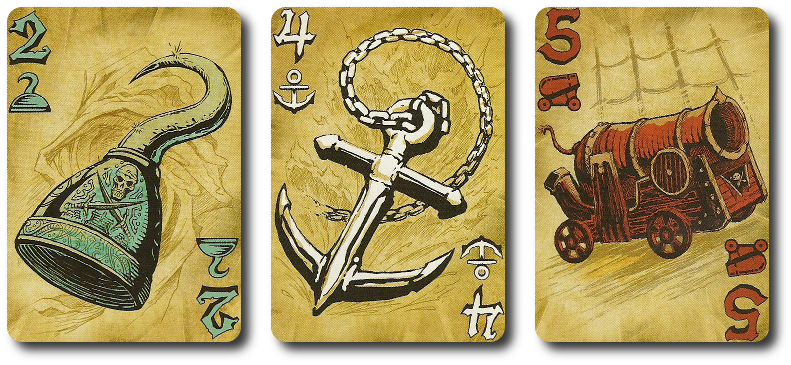
Step 3: Draw Again or Collect
The player now has a choice to make. They can either collect all the Loot cards in the Play Area or risk drawing more cards. If the player wants to collect the cards, they take all the face-up Loot cards in the Play Area and add them to their Loot Stacks. The player’s turn is now over.
If the player wants to risk it, they can keep going by drawing another card. Essentially, they start over and repeat step 1 noted above. All cards in the Play Area remain until the player chooses to collect or they bust.
Busting Like an Albatross
“Busting” means that there are 2 Loot cards in the Play Area that share the same suit. A busted Play Area results in all the cards in the Play Area being collected and sent to the Discard Pile. Busts happen before the card is placed in the play area, which means the Loot card that causes the bust does not have its Suit Ability triggered. Consequently, a Bust also signals the end of the player’s turn.
Collecting Like a Pirate Boss
If the player chooses to collect the Loot cards, their turn ends and they take all the Loot cards in the Play Area, claiming them as their own. These collected Loot cards are organized in the player’s Loot Stack. The area in front of the player where the Loot Stacks are kept is referred to as the player’s Bank. In total, a player will have up to 10 total Loot Stacks (one per suit). Each Loot Stack is organized so the highest Loot card value for that suit is on top and the lowest is on the bottom. Loot Stacks are always kept face-up, but the player’s are welcome to organize the different stacks however they like based on the playing space available.
Using Pirate Traits
Each player has a Trait card. Trait cards trump a Suit Ability and game play. All Traits are considered “on” at all times during the game and MUST be activated if possible. It’s also worth noting that the Trait is triggered for both the player and their opponent’s, but the wording describing a few of the Traits is a bit vague. Expect the occasional argument to spring up regarding Traits and their general effects.
In total, there are 17 Traits. Each of the Traits are briefly summarized here.
- Beastmaster (trumps “Kraken”): Opponents (not the player) must draw 4 Loot cards instead of 2 when the “Kraken” suit is drawn.
- Captain’s Hook (trumps “Hook”): Must play 2 Loot cards from your Bank instead of 1 Loot card.
- Casanova (trumps “Mermaid”): Mermaids are Banked automatically.
- Davy Jones’ Locker (trumps “Bust”): You Bank your opponent’s cards when they bust.
- Fisherman (trumps “Kraken”): “Kraken” suits are Banked automatically and do not trigger the normal “Kraken” Suit Ability.
- Golden Scales (trumps “Mermaid”): All Banked “Mermaids” are worth +5 points at the end of the game.
- Miser (trumps “Hook”): Protects “Hook” and additional Loot card played from a Bust.
- Navigator (trumps “Map”): Pick any 1 Loot card from the Discard Pile instead of the normal 3 randomly drawn Discard Pile cards.
- Master Gunner (trumps “Cannon”): Discard the entire Loot Stack instead of just the top card.
- Misfire (trumps “Cannon”): Each opponent who draws a “Cannon” Loot card must place the top card of a Loot Stack from their OWN Bank to the Discard Pile.
- Mystic (trumps “Oracle”): Reveal 3 Loot cards instead of 1 Loot card.
- Parry (trumps “Sword”): Opponent’s “Sword” Loot card must steal a “Kraken” Loot card.
- Plunderer (trumps “Chest” and “Key”): Bonus cards come from an opponent’s Bank instead of the Discard Pile.
- Safe Harbor (trumps “Anchor”): The “Anchor” Loot card and the next 2 Loot cards are protected from a Bust.
- Scavenger (trumps “Cannon”): Place the targeted Loot card into your Bank instead of the Discard Pile.
- Swordsman (trumps “Sword”): Steal the top Loot card from any Loot Stack, regardless if you have the same suit or not.
- Treasure Hunter (trumps “Chest” and “Key”): Triples the number of Loot cards you can collect from the Discard Pile when collecting with “Chest” and “Key” Loot cards.
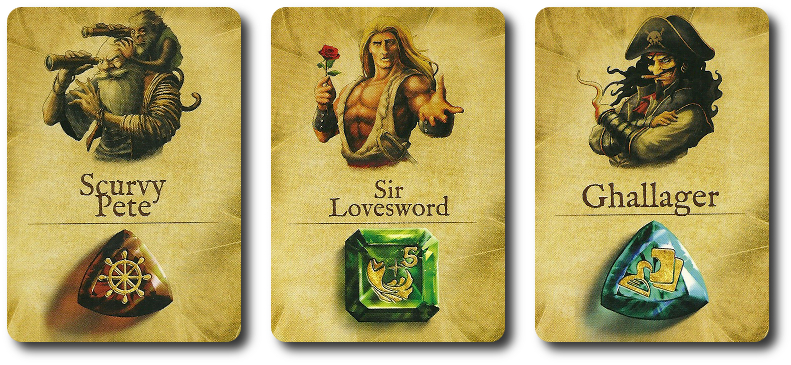
Dropping Anchor
The game ends when the last Loot card is drawn from the Draw Pile. The Player who drew the last Loot card completes their turn (be it through collecting or busting) and then everyone turns their attention to their Bank.
Only the most valuable (read: “highest numbered”) Loot cards are scored for each suit. These should be the cards already on top of each player’s Loot Stacks. Add these numbers up to determine each player’s Loot Total. The player with the highest Loot Total wins the game. Ties are broken by counting the total number of Loot cards in a player’s Bank, which victory going to the player who has the most cards collected.
Game Variants
A number of game variants are available to use if players are looking to change the normal game play (which is already pretty random) or are looking for a specific type of game play.
Pirate Party
Dead Man’s Draw can only sit a maximum number of 4 players. By combining a second copy of the game, up to 8 players can join in. While this game variant only suggests you combine two games, there is nothing stopping you from combining 3 or more, but that might not be a good idea.
Web Variants
The 6 Web Variant cards included in the game change how Banks are scored, Busts are resolved, and games are won. They provide an interesting and challenging mix of additional ducking and dodging in this already tricky risk versus reward card game. While the rewards are still the same (there is always only 1 winner), the path to victory is greatly changed by the Web Variant cards, making normal game play seem like child’s play. Before playing a game, select 1 or more Web Variants to be used and set them to one side of the playing area, face-up, and visible to all.
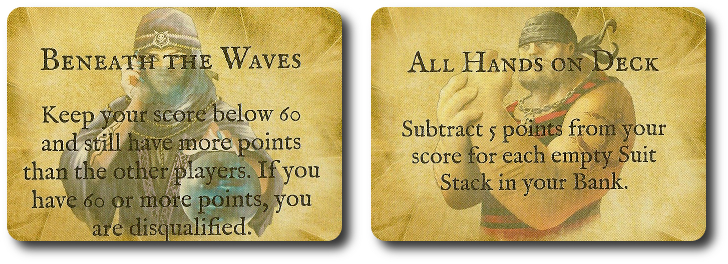
House Rules
Trash the Traits
Players either loved or hated the Trait cards. Some felt it provided a lot of replayability while others felt that Traits hurt game play. We attempted to play the game without the Trait cards to see if the game needed them or not. Guess what? The game doesn’t need them. Nor did a lot of our players. This House Rule just removes the Trait cards from play, making them an interesting addition to your game, but no more necessary than the Web Variant cards.
To learn more about Dead Man’s Draw, visit the game’ web page.
Final Word
The Child Geeks were surprisingly mixed when it came time to approve or reject Dead Man’s Draw. Apparently, some of the Child Geeks felt that the game unfairly ended turns and made decisions for the players. According to one Child Geek, “I like the game OK, but I don’t like how I cannot do anything about the cards when I draw them.” Another Child Geek said, “There are way too many special cards in this game. I just want to try to collect them without busting, but I spend more time trying to figure out what each card does than actually playing my turn.” This comment came up a number of times. The majority of cards have special effects that are triggered that caused ripples of dislike in all our groups. Finally, one Child Geek said, “I like the game. It reminds me of Zombie Dice, but instead of shoot guns and brains, I have krakens and swords.” When the game was docked, the Child Geeks decided that it was a great game for some and a miss for others.
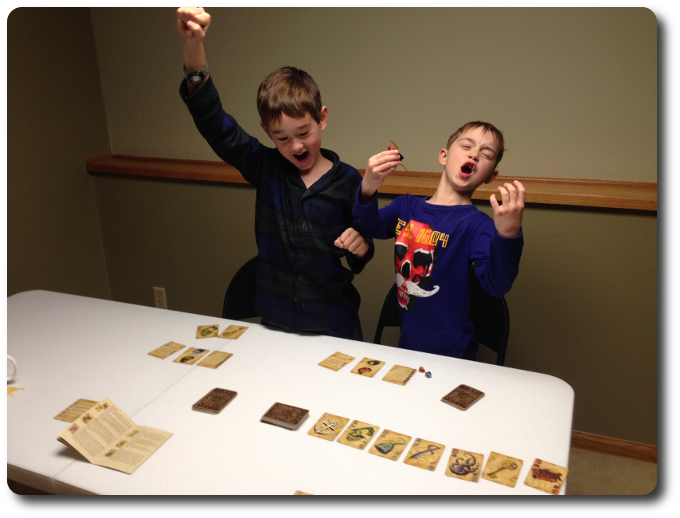
A tense moment results in a Key and Chest! Victory for one Child Geek, certain defeat for another…
The Parent Geeks mentioned many of the same dislikes as their younger peers. The multiple card effects kept game play slower than they would like. It took time to figure out what each effect was and then more time to resolve it. According to one Parent Geek, “you sometimes spend more time figuring out what a card does versus just playing the game.” I wouldn’t consider this a learning curve, but having a good memory does certainly speed up the game. After several games, the players only occasionally referred to the rule book or Player Reference cards. This certainly sped up the game play and increased the game’s entertainment value. After sailing the game into choppy waters, the Parent Geeks emerged into clear skies, agreeing that Dead Man’s Draw was an entertaining game of risk and reward.
The Gamer Geeks, who are used to playing games that have effects, after effects, after effects, didn’t even blink at how many times they had to stop and quickly read what the drawn card did or did not do in the game. To them, it was just part of learning the game. What they focused on the most was how much information the game provided. According to one Gamer Geek, “This game gives you a lot of information. You know what cards your opponents have and given that, you can make some assumptions on how many cards are left of a certain suit. That’s pretty cool. As the game progresses, you must take more risk to win the game, but risking early is still a good idea.” While all the Gamer Geeks liked the majority of the game, they were not big fans of the Traits. They felt that these were unimportant to game play and added one additional level of administration to resolve turns that was not necessary. More to the point, they felt that the game was a bit fiddly at times, resulting in too much time spent on resolution of effects rather than just playing the game. This resulted in the Gamer Geeks having mixed thoughts overall, neither approving or rejecting Dead Man’s Draw.
To understand Dead Man’s Draw, I think you must first understand how it was born. This a game that was designed to test, build, and refine what would later be a video game. With video games, you can put a lot of the heavy lifting of resolving effects and managing game flow into the programming. For traditional card, board, and dice games, all the heavy lifting must be done by the players. The game might provide the method, but the players are responsible for seeing it through. In the case of this game, all the bells and whistles that make the video game version of Dead Man’s Draw so appealing equate to time spent resolving everything the game randomly throws at you. That can get old, especially when the card game feels heavier than it should, demanding more time of its players than some might believe necessary.
But none of this is a “bad thing”. It’s just “a thing” that might or might not even register for a player. Personally, I didn’t mind the Suit Abilities one bit. I liked how they kept sweeping over the game, causing just enough chaos to make me carefully consider the risk of flipping over another card.
I cannot say the same for the Traits. I think the Traits are a mistake, personally. The Suit Abilities have enough impact on the game to make it entertaining. The Traits add one more random element to resolve that felt secondary and somewhat disconnected. We played without the Traits (see House Rules) and no one thought the game suffered for it.
As for the Web Variants, I found them to be forgettable, but a nice touch. They allow slight variations in the game play and victory condition that increases the game’s replayablity. Unlike the Trait cards, they didn’t add steps or time to the game. Like the Trait cards, I think the Web Variant cards are just “extra stuff” that have no intrinsic value. They are there if you want them, but what they bring to the table is not overly beneficial to the game. It’s just more stuff to ponder and play with. For some of our players, that was great news. For others, it wasn’t newsworthy whatsoever.
Overall, an entertaining press-your-luck card game. Its subtle flaws are easily resolved, the game play suffers a bit until you take the time to learn all the Suit Abilities, and there is enough randomness to make each game play very different. If you are looking for a pirate themed card game where fortune favors the bold, do play Dead Man’s Draw.
This game was given to Father Geek as a review copy. Father Geek was not paid, bribed, wined, dined, or threatened in vain hopes of influencing this review. Such is the statuesque and legendary integrity of Father Geek.
Discover more from Father Geek
Subscribe to get the latest posts sent to your email.





